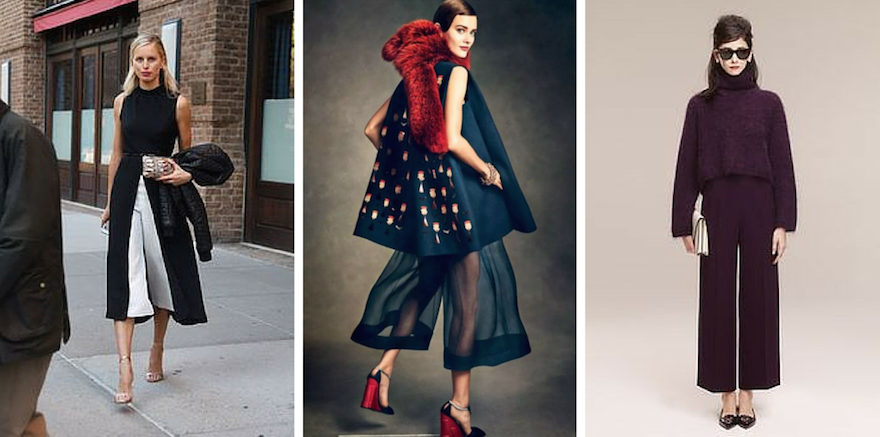

Culottes have made a definitive comeback in the past few seasons, this year in particular. Opinions on them are definitely polarizing- some say the bold look is incredibly chic, others claim it is “aggressively unsexy.” However you feel, it’s safe to say that these pants are comfy, and versatile- definitely the perfect summer staple to combat these past few sweaty months.
This is hardly the pant’s first time in the fashion limelight however. Culottes have a long, tumultuous history, and have gone through a number of changes throughout the years.
So what are culottes?
It’s a bit of a trick question- the answer depends on what point in time you are referring. While today the term refers to women’s wear, its first iteration was as a men’s pant. The word was used as far back as the Renaissance- men of upper class would wear breeches, which in France was translated from English into French as “culottes.” This early version was nothing like the ones worn today. These pants were fitted, often cut from fine silk, and ended just below the knee with a fastener such as a buckle or button.
At first glance, culottes are simply pants and nothing more. However, the garment has been caught up in scandal since it’s early days. By the late 1700’s the French Revolution culottes, which were frequently worn by the wealthy, became a symbol of the upper class and oppression. So much so, revolutionaries were referred to as “sans culottes” or “without culottes,” referring to their station and opposition to aristocratic ideas. These sans culottes wore trousers instead, creating a stark visual divide between classes and values.
But the French Revolution certainly wasn’t the end of it. The drama surrounding culottes only intensified as they made the transition from a symbol of male wealth into a freeing, feminist garment for women. This version, a skirt split into pants, is much more in line with what we know culottes as today.
Women’s culottes came about in the Victorian era, as women of the time started to become much more active than they had in previous generations. They were participating in activities such as horseback riding, tennis, and especially bicycling. However, the cumbersome skirts of the period were definitely not conducive to sports, or really anything other than sitting while looking pretty.
The bifurcated skirts of the Victorian era were originally created as garments that would give the illusion of wearing a long skirt while enabling women to straddle a horse instead of riding sidesaddle. Ruffles or panels helped to conceal the divide, allowing the wearer to ride horses and bikes properly. The French word “culottes” was borrowed and used to refer to these new women’s pants. Women enjoyed a newfound freedom in the Victorian version of culottes, and fortunately, did not need to endure much social backlash as a result of their sartorial choices. This garments looked enough like a skirt that few made too much of a fuss.
This would eventually change however, because the further the design of culottes moved from that of a traditional skirt, the more contentious the garment became. French designers began experimenting with the idea of divided skirts as they became more of a staple in women’s wardrobes.
However, it was Elsa Schiaparelli who would make the bold move of creating culottes that made no attempt to hide what they really were: pants for women.
In 1931, Schiaparelli caused a scandal during a trip to London to go fabric shopping. The designer wore culottes that were “undisguised by panels or a wraparound skirt.” The Bristish press tore Schiaparelli’s design apart, calling them “manly, with hints of lesbianism.” Though this is a ridiculous insult by today’s standards (in fact, now it could even be considered a compliment) the jabs got worse, even downright hostile. For example, Lili de Alvarez, a professional tennis player, wore a Schiaparelli design at Wimbledon. This outraged reporters at the Daily Mail, who declared that she should be “soundly beaten.” In fact, for a time, there was a French law that expressly forbade women wearing pants unless she was “holding a bicycle handlebar or the reigns of a horse.” Women were arrested in Paris for wearing culottes in public.
Fortunately, this outrage was short-lived, and pants for women became socially acceptable as attitudes and gender roles evolved in the subsequent decades. The wide-legged culottes fell out of fashion in favor of other styles, but, as we know, have recently made a comeback.
While public opinion on modern culottes is not nearly as “passionate” as it was in the 1930’s, its “aggressive” unsexiness is still a point of contention, even today. But looking back through its history, culottes were never meant to be sexy. And perhaps that’s a good thing.

Samantha
Thank you for giving us the backstory on culottes. I like to know the history of trends.